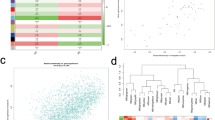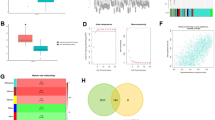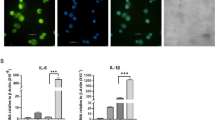Abstract
Objective
CCAAT/enhancer binding protein β (C/EBPβ) plays an important role during atherogenesis. However, how C/EBPβ functions remains unclear. In this study, we explore the relationship between C/EBPβ and oxidized LDL-induced multiple pro-inflammatory cytokines released in monocytes.
Materials and methods
THP-1 cells (human monocyte cell line) were stimulated by ox-LDL, ChIP was used to detect the binding function of C/EBPβ to target genes, small interfering RNA was used to knock down the expression of C/EBPβ, Western Blot was used to detect protein expression, and ChIP-seq was used to detect different groups of C/EBPβ bound gene fragments. The integrative genomics viewer (IGV), model-based analysis of ChIP-seq (MACS) were used to visualize the results of ChIP-seq. GO (gene ontology), KEGG (Kyoto Encyclopedia of Genes and Genomes) and Reactome data bases enrichment analysis were performed by the ClusterProfiler software. Ingenuity pathway analysis (IPA) was used to analyze the results of ChIP-seq and to summarize the data within the database.
Results
We identified C/EBPβ as a key protein that regulated IL-1β, IL-6 through database. Then our results confirmed that C/EBPβ could bind directly to the gene of IL-18 and C/EBPβ plays a role in the increased expression and secretion of IL-18 protein after ox-LDL stimulation of THP-1. Using ChIP-seq, we found that the enhanced transcriptional function of C/EBPβ after ox-LDL treatment triggered changes in C/EBPβ-regulated downstream pathways. In the ChIP-seq results, we extracted inflammatory cytokines with significant expression differences, and by comparing them with the database of inflammatory cytokines that C/EBPβ directly regulated, we screened five inflammatory cytokines, CXCL8, IL17B, TNFSF11, CSF3, and CCL2, and the results showed that knockdown of C/EBPβ expression inhibited ox-LDL-induced secretion of CXCL8, TNFSF11, CSF3, and CCL2 by THP-1.
Conclusion
Our results suggest that ox-LDL stimulation enhances C/EBPβ-regulated transcription in THP-1 and C/EBPβ upregulate the release of multiple pro-inflammatory cytokines including IL-18, IL-1β, and IL-6 through direct binding to genes.





Similar content being viewed by others
References
Libby P. The changing landscape of atherosclerosis. Nature. 2021;592:524–33.
Ridker PM, Everett BM, Thuren T, MacFadyen JG, Chang WH, Ballantyne C, Fonseca F, Nicolau J, Koenig W, Anker SD, Kastelein JJP, Cornel JH, Pais P, Pella D, Genest J, Cifkova R, Lorenzatti A, Forster T, Kobalava Z, Vida-Simiti L, Flather M, Shimokawa H, Ogawa H, Dellborg M, Rossi PRF, Troquay RPT, Libby P, Glynn RJ and Group CT. Anti-inflammatory therapy with canakinumab for atherosclerotic disease. N Engl J Med. 2017;377:1119–31.
Everett Brendan M, MacFadyen Jean G, Thuren T, Libby P, Glynn Robert J, Ridker PM. Inhibition of interleukin-1β and reduction in atherothrombotic cardiovascular events in the CANTOS Trial. J Am Coll Cardiol. 2020;76:1660–70.
Ridker PM, MacFadyen JG, Thuren T, Libby P and Group obotCT. Residual inflammatory risk associated with interleukin-18 and interleukin-6 after successful interleukin-1β inhibition with canakinumab: further rationale for the development of targeted anti-cytokine therapies for the treatment of atherothrombosis. Eur Heart J. 2019;41:2153–63.
Pamukcu B, Lip GYH, Shantsila E. The nuclear factor—kappa B pathway in atherosclerosis: a potential therapeutic target for atherothrombotic vascular disease. Thromb Res. 2011;128:117–23.
Gage J, Hasu M, Thabet M, Whitman SC. Caspase-1 deficiency decreases atherosclerosis in apolipoprotein E-Null mice. Can J Cardiol. 2012;28:222–9.
Siersbæk R, Rabiee A, Nielsen R, Sidoli S, Traynor S, Loft A, La Poulsen Lars C, Rogowska-Wrzesinska A, Jensen Ole N, Mandrup S. Transcription factor cooperativity in early adipogenic hotspots and super-enhancers. Cell Rep. 2014;7:1443–55.
van der Krieken SE, Popeijus HE, Mensink RP, Plat J. CCAAT/enhancer binding protein β in relation to ER stress, inflammation, and metabolic disturbances. Biomed Res Int. 2015;2015:324815.
Rahman SM, Baquero KC, Choudhury M, Janssen RC, de la Houssaye BA, Sun M, Miyazaki-Anzai S, Wang S, Moustaid-Moussa N, Miyazaki M, Friedman JE. C/EBPβ in bone marrow is essential for diet induced inflammation, cholesterol balance, and atherosclerosis. Atherosclerosis. 2016;250:172–9.
Fuhrman B, Partoush A, Volkova N, Aviram M. Ox-LDL induces monocyte-to-macrophage differentiation in vivo: Possible role for the macrophage colony stimulating factor receptor (M-CSF-R). Atherosclerosis. 2008;196:598–607.
Tabas I, Bornfeldt KE. Macrophage phenotype and function in different stages of atherosclerosis. Circ Res. 2016;118:653–67.
Sims JE, Smith DE. The IL-1 family: regulators of immunity. Nat Rev Immunol. 2010;10:89–102.
Tsukada J, Saito K, Waterman WR, Webb AC, Auron PE. Transcription factors NF-IL6 and CREB recognize a common essential site in the human prointerleukin 1 beta gene. Mol Cell Biol. 1994;14:7285–97.
Song J, Yang S, Yin R, Xiao Q, Ma A, Pan X. MicroRNA-181a regulates the activation of the NLRP3 inflammatory pathway by targeting MEK1 in THP-1 macrophages stimulated by ox-LDL. J Cell Biochem. 2019;120:13640–50.
Tanaka T, Narazaki M, Kishimoto T. IL-6 in inflammation, immunity, and disease. Cold Spring Harb Perspect Biol. 2014;6:a016295.
Grebe A, Hoss F, Latz E. NLRP3 inflammasome and the IL-1 pathway in atherosclerosis. Circ Res. 2018;122:1722–40.
Plevy SE, Gemberling JH, Hsu S, Dorner AJ, Smale ST. Multiple control elements mediate activation of the murine and human interleukin 12 p40 promoters: evidence of functional synergy between C/EBP and Rel proteins. Mol Cell Biol. 1997;17:4572–88.
Matsusaka T, Fujikawa K, Nishio Y, Mukaida N, Matsushima K, Kishimoto T, Akira S. Transcription factors NF-IL6 and NF-kappa B synergistically activate transcription of the inflammatory cytokines, interleukin 6 and interleukin 8. Proc Natl Acad Sci. 1993;90:10193–7.
Chistiakov DA, Sobenin IA, Orekhov AN. Vascular extracellular matrix in atherosclerosis. Cardiol Rev. 2013;21(6):270–88.
Reynolds Joseph M, Lee Y-H, Shi Y, Wang X, Angkasekwinai P, Nallaparaju Kalyan C, Flaherty S, Chang Seon H, Watarai H, Dong C. Interleukin-17B antagonizes interleukin-25-mediated mucosal inflammation. Immunity. 2015;42:692–703.
Moreau M, Brocheriou I, Petit L, Ninio E, Chapman MJ, Rouis M. Interleukin-8 mediates downregulation of tissue inhibitor of metalloproteinase-1 expression in cholesterol-loaded human macrophages. Circulation. 1999;99:420–6.
Di Bartolo BA, Cartland SP, Harith HH, Bobryshev YV, Schoppet M, Kavurma MM. TRAIL-deficiency accelerates vascular calcification in atherosclerosis via modulation of RANKL. PLoS ONE. 2013;8:e74211.
Haghighat A, Weiss D, Whalin MK, Cowan DP, Taylor WR. Granulocyte colony-stimulating factor and granulocyte macrophage colony-stimulating factor exacerbate atherosclerosis in apolipoprotein E-deficient mice. Circulation. 2007;115:2049–54.
Winter C, Silvestre-Roig C, Ortega-Gomez A, Lemnitzer P, Poelman H, Schumski A, Winter J, Drechsler M, de Jong R, Immler R, Sperandio M, Hristov M, Zeller T, Nicolaes GAF, Weber C, Viola JR, Hidalgo A, Scheiermann C, Soehnlein O. Chrono-pharmacological targeting of the CCL2-CCR2 axis ameliorates atherosclerosis. Cell Metab. 2018;28:175-182.e5.
Funding
Studies were funded by the National Natural Science Foundation of China (No. 81900404).
Author information
Authors and Affiliations
Contributions
JM responsible for study design, data collection, analysis, and manuscript draft. XY was responsible fordata collection,analysis, and manuscript draft. XC was responsible for the critical revision of article.
Corresponding author
Ethics declarations
Conflict of interest
None.
Additional information
Responsible Editor: John Di Battista.
Publisher's Note
Springer Nature remains neutral with regard to jurisdictional claims in published maps and institutional affiliations.
Supplementary Information
Below is the link to the electronic supplementary material.
Rights and permissions
About this article
Cite this article
Ma, J., Yang, X. & Chen, X. C/EBPβ is a key transcription factor of ox-LDL inducing THP-1 cells to release multiple pro-inflammatory cytokines. Inflamm. Res. 70, 1191–1199 (2021). https://doi.org/10.1007/s00011-021-01509-3
Received:
Revised:
Accepted:
Published:
Issue Date:
DOI: https://doi.org/10.1007/s00011-021-01509-3




